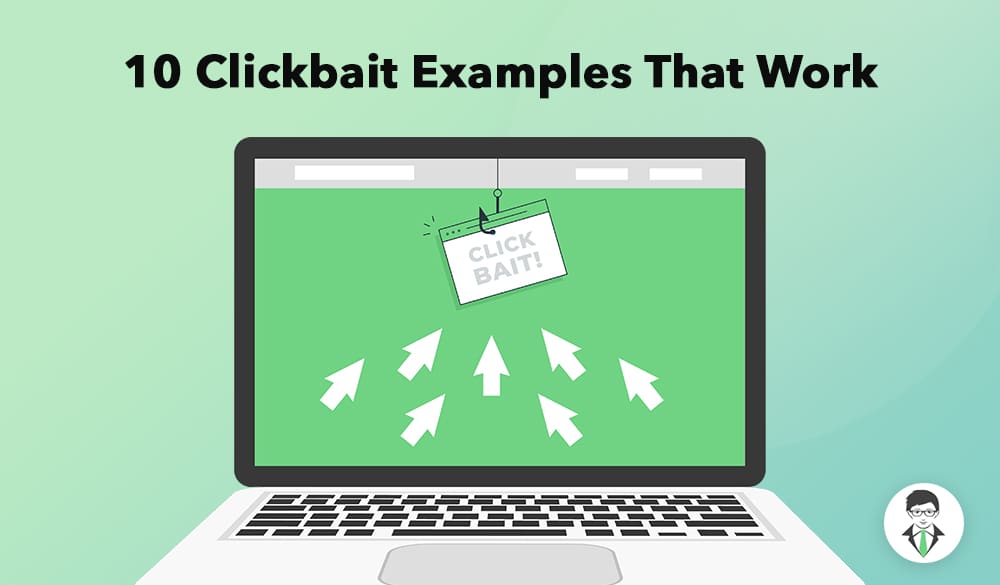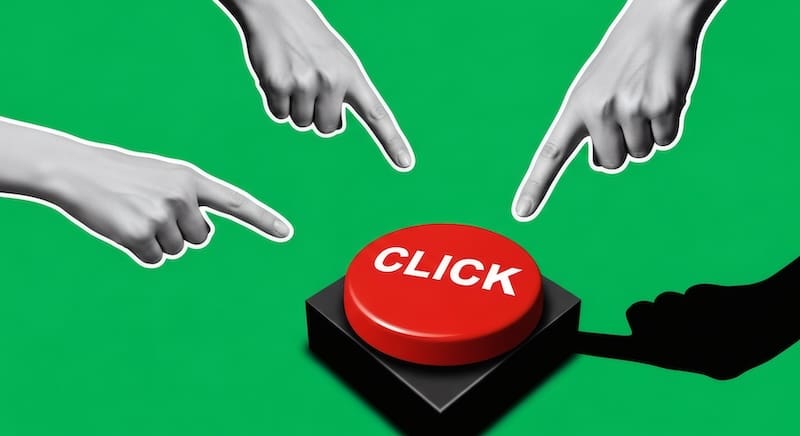With the clickbait examples in this article, we’ll show you the types of clickbait titles that actually work.
We’ve all fallen for an irresistible headline at one time or another. Online media or news websites post a title that promises a life-changing tip, shocking secret or unbelievable fact. Before you know it, you’re distracted from whatever you were doing and you click.
You simply can’t help yourself. That’s the power of clickbait.
Clickbait headlines tend to get a bad reputation, but not all clickbait strategies are as misleading as you may think. At the root of clickbait tactics is emotional marketing, which combines curiosity, storytelling and urgency. When you put this together, clickbait titles make people want to — need to — know more.
For brands that are working on their online reputation, knowing how to use clickbait headlines effectively is a powerful way to market content. Many of the same triggers that push people to click also capture the attention of your audience, build trust and shape the digital perception of your brand.
NetReputation can help you leverage your online content to improve your digital reputation. Call us at 844-461-3632 to learn more, or fill out the contact form below for a free consultation.
Request a Free Consultation
What Makes Clickbait Headlines Work?
What is the secret behind how clickbait headlines work? Let’s dive into what makes clickbait strategies so effective by exploring the power of promises, the lure of curiosity, emotional triggers, and the impact of engaging headlines and visual appeal. Get ready to unravel the captivating strategies that keep us clicking and discover why clickbait continues to dominate our online experience.
What Makes Clickbait Effective?
- Promises and Curiosity: Clickbait creates a sense of mystery and promises to reveal something intriguing or unbelievable.
- Emotional Triggers: Clickbait taps into our emotions, whether it’s curiosity, shock, or the desire for improvement.
- Engaging Headlines: Clickbait headlines use strong language, powerful words, and a sense of urgency to grab our attention.
- Visual Appeal: Clickbait often includes eye-catching visuals that entice readers to click and explore.
Promises and Curiosity
Promises and curiosity play a vital role in the effectiveness of clickbait. Bold assertions and intriguing phrases attract readers and entice them to click to read a clickbait article.
For instance, phrases like “You Won’t Believe What This Celebrity Did!” or “The Shocking Truth Behind a Popular Wellness Trend” exemplify how clickbait promises to deliver exciting information to readers.
Clickbait headlines leverage human curiosity, resulting in high click-through rates and increased website traffic. The use of mind-blowing or life-changing promises further encourages reader engagement.
It is worth noting that not all clickbait lives up to its headline promises. Some clickbait may end up disappointing readers, ultimately harming a website’s reputation. Content creators must ensure that their headlines accurately represent the content and successfully satisfy the curiosity of their readers.
Emotional Triggers
Emotional triggers play a vital role in the effectiveness of clickbait headlines. They can tap into people’s emotions and ignite a strong desire to gain further knowledge. In the realm of clickbait, there are several common emotional triggers employed:
- Curiosity: This particular trigger captivates attention by promising captivating or enigmatic information or stories.
- Fear: One can appeal to fears by highlighting potential dangers, threats, or shocking revelations.
- Surprise: Engaging readers with unexpected or astonishing information immediately grabs their attention.
- Excitement: Generating anticipation is possible through the usage of words like “amazing,” “incredible,” or “mind-blowing.”
- Desire: Triggering desires and aspirations happens by providing solutions, secrets, or advice to enhance individuals’ lives.
Carefully crafted emotional triggers manipulate readers’ emotions and urge them to click. Stirring up potent emotions results in higher click-through rates and engagement.
Engaging Headlines
A strong headline does more than inform — it compels the user to take action. Clickbait headlines commonly use emotionally charged words, time-sensitive phrases or even numbers to create a sense of importance and urgency. Phrases like “you won’t believe” and “before time runs out” tap into our instinct to stay informed and not miss out on whatever the clickbait headlines promise.
Consider the headline “10 Mind-Blowing Facts About an 87-Year-Old Fitness Trainer.” In this headline, a numbered list and the phrase “mind-blowing,” along with the shocking element of the fitness trainer’s age, create curiosity and promise valuable and surprising information.
Similarly, consider the headline “How a Simple Ice-Breaking Technique Led to a Lifetime Friendship.” This catchy headline engages readers by promising a simple technique and piquing curiosity about the story behind a lasting friendship. For anyone who cares to develop a lifetime friendship, this headline will be difficult to resist.
Visual Appeal
Visual appeal is a vital aspect of creating clickbait headlines that grab attention. Eye-catching images, compelling design, infographics, video thumbnails, and intriguing visuals make clickbait headlines more enticing.
Bright colors, striking visuals, and captivating thumbnails can seize the reader’s attention and entice them to click. Well-designed layouts and typography enhance the visual appeal of the content. Informative and visually pleasing infographics are an effective way to convey information quickly.
For example, visually appealing and intriguing video thumbnails can significantly increase clicks. Ultimately, clickbait becomes more appealing by utilizing visuals that spark curiosity or evoke emotions.
10 Clickbait Examples That Work
Clickbait headlines are everywhere — from celebrity gossip to health hacks to legitimate news websites — and they all share one goal: getting you to click. Below are some of the most common and effective examples of clickbait headlines that show how curiosity, emotion, and urgency can turn an ordinary title into something irresistible.
1. “You Won’t Believe What This Celebrity Did!”
Clickbait headlines like “You Won’t Believe What This Celebrity Did!” instantly capture our attention. These captivating headlines are designed to generate curiosity and evoke emotion, enticing readers to click and discover the shocking details. The effectiveness of this technique lies in its ability to grab attention amidst stiff competition from news articles.
Clickbait articles rely on driving traffic to websites, which is measured by click-through rate. However, the best clickbait will lead to high-quality content that delivers on the promise. Maintaining good quality is crucial for publishers, as poor clickbait can damage their reputation.
2. “5 Secrets for Instant Weight Loss Revealed”
This clickbait example — “Find Out How This Entrepreneur Made Millions in Just One Year” — captures the attention of online visitors and entices them to click on the link.
- The phrase “find out how” invites readers to uncover a success formula. This positions the content as both informative and attainable.
- Mentioning “millions” and “just one year” adds a sense of achievement and urgency. This appeals to readers’ ambitions and desire for rapid results.
- By highlighting a specific individual’s success, the headline adds a storytelling element that feels personal and relatable.
This clickbait example arouses readers’ curiosity with the assurance of uncovering the secrets behind an entrepreneur’s rapid financial success.
5. “10 Life Hacks That Will Change Your Life Forever.”
The enticing article title “Discover the Ancient Secret for Eternal Youth” promises valuable insights that the reader probably doesn’t know yet. It effectively captures the interest of individuals who are intrigued by preserving their youthful appearance.
- The word “discover” implies that hidden knowledge is waiting in the article.
- The phrase “ancient secret” suggests wisdom that has stood the test of time. This adds credibility and allure.
- “Eternal youth” taps into the universal human desire to look and feel young forever.
The article’s headline is a captivating hook, employing visual power words to seize attention immediately. By blending exclusivity, desire and a bit of mystery, the headline promises transformation — and that’s hard to ignore.
8. “Unbelievable Deals: Get This Product for Free!”
“Unbelievable Deals: Get This Product for Free!” is a prime example of enticing clickbait that captures readers’ attention by promising a cost-free product. This particular form of clickbait commonly incorporates phrases such as “limited-time offer” or “exclusive promotion” to create a sense of urgency. Offering complimentary items appeals to readers and encourages them to click on the associated article or advertisement.



